Problem Statement
Introduction
This dissertation critically investigates the convenience of utilizing alternative energy sources and their feasibility and effectiveness in the economic reality to assess the future prospect of business in the context of the finiteness of existing energy resources. In the modern world, the growing requirement for more energy has generated serious pressure on the global oil and gas resources while decreasing energy intensity has threatened the usual economic growth; so, the energy experts are emphasizing to reduce the dependency on fossil fuel and advising to utilize alternative energy sources. This mini-dissertation will deal with the seven major chapters and sub-chapters such as executive summary, aims, and objectives, introduction and definition of the topic, literature review/arguments, research methodology, data structure and collection, data analysis, data structure and collection, recommendations, and conclusion in order to attain its objectives.
Background of the Problem
The concurrent global economy has been going through the most hazardous impact of the global financial crisis from 2008 where the increasing oil price has alarmed the global economy to draw awareness of the policymakers to rethink the finite energy resources and look for alternative energy sources that could efficiently meet up the rising energy needs of the society. As a result, the society has been trying to reduce dependency on petrochemicals and oil resources and moving towards renewable energies like geothermal, hydropower, nuclear power, solar power, ocean energy conversion; however, the environmental hazard from energy generation and the associated threat of climate change have generated public awareness to endow with the sustainable alternative of energy sources.
Stern (2007, p.62) presented the economics of climate change and pointed out that the implications for energy demand and emissions in the developed and developing countries could raise the damage up to 20% of their GDP or more by the coming decade. Stern (2007, p.40) also added that emissions and environmental threats could be reduced by increased utilization of renewable energy, improved energy efficiency, and engaged further low-carbon energy sources although reserve of identified fossil fuel resources still could meet up half of the global energy up to 2050; therefore, it is emergence to identify the sustainable alternative resources right now. With this background problem, this dissertation has aimed to conduct a comparative study with the alternative energy resources with costs and risks assessment by reviewing the existing and future resources and their possible impact on the business for changes in energy technologies.
Rationale of the Research
There are adequate numbers of research regarding the finite energy resources of fossil fuels and there are also enormous studies with the alternative energy resources, but there is no research agenda has yet been raised that deals with the existing, alternatives, and future energy resources concurrently linking with their economic and business reality. Thus, it is logical to conduct an investigation on the possible use of alternative energy sources whilst reviewing the already existing and possible future resources and their impact on business, and this dissertation would develop a conceptual framework that would assist the business and academia with a greater understanding in this regard.
Aim and Objectives of the Research
This researcher has intended to investigate with the sustainable alternative energy resources that would be capable to meet up future energy requirements based on the economic reality of the dwindling supplies of existing energy resources with the aim to understand how future energy resources would shape the global economy focusing on the significant business opportunities generated from the new technology. To attain such aim and objectives, this dissertation has planned to address the subsequent research questions and the answer to these questions would allow the readers and policymakers with better understanding to organize new policy towards a greater motivation to integrate alternative resources by conserving existing resources; however, the research questions are provided as follows:
- How the theoretical framework of alternative energy resources emerged and developed?
- To what extent the finiteness of existing energy resources has threatened the global economy;
- How the future energy sources would influence the global economy by generating significant business opportunities?
Literature Review
Defining Alternative Energy
Renewable energy indicates energy that occurs naturally and repeatedly in the environment; it can be found from water, wind, the sun, and geothermal heat or plants; however, it generally falls into two categories, for instance, substitutes for existing petroleum liquids and alternatives for the generation of electric power (Herzog, Lipman & Kammen, 2001; Peltier, 2010; Kruger, 2006; and Fridley, 2010). Most importantly, these resources are replenished or available for a long time; at the same time, these resources contain biomass and fossil feedstock, photovoltaic, hydropower, solar thermal, tidal, and so on (WWF, 2011; Rosentrater & Al-Kalaani, 2006; Kruger, 2006; and Fridley, 2010, p.3). Alternative or renewable energy can play a vital role to reduce carbon emission; however, renewable energy production varies country by country as climate patterns strongly influence the operating features of these resources (Oren, Callaway, Mathieu & Papavasiliou, 2010; WWF, 2011; and Rosentrater & Al-Kalaani, 2006).
Significance of alternative Energy
At present, developed countries depend heavily on non-renewable fossil fuels, such as coal, oil, and natural gas for its energy though these are finite resources (Kruger, 2006; and Morgan, 2009); these resources are not reusable, but the consumption of such resources is increasing day-by-day, for instance, the following figure shows world energy consumption by fuel type:

These finite resources can be found in different parts of the world, for instance, the Middle East countries and GCC member states have the largest oil deposits; on the other hand, alternative energy resources, for example, wind, solar thermal and ocean energy are constantly replenished and will never end (Anny, Blackman & Baumol, 2008; Krautkraemer, 2003; and CSAG, 2011). However, the consumption of finite fossil fuels is increasing to produce electricity or heat because of the high global population and economic development, for example, in the UK, greenhouse gas emissions were more than 636MtCO2, and electricity production is liable for above 543MtCO2 for each year (WWF, 2011; Rosentrater & Al-Kalaani, 2006; Peltier, 2010; and Fridley, 2010, p.3).
At the same time, there are many influential factors related to fuel consumption for which it needs to use renewable resources, such as, carbon emissions from over-dependency on finite resources lead to climate change and global warming (WWF, 2011; Rosentrater & Al-Kalaani, 2006; Peltier, 2010; Krautkraemer, 2003; and CSAG, 2011 and Oren et al., 2010). In addition, many countries have to import fuels in order to meet energy demand, which increases the power of the suppliers; therefore, it creases problems related to national security (Rosentrater & Al-Kalaani, 2006; Peltier, 2010; Krautkraemer, 2003; CSAG, 2011; and Fridley, 2010). Furthermore, the industrial development had hampered due to lack of energy resources, uncertainty over its costs, or volatility of the fuel prices in the developing countries (Peltier, 2010; Krautkraemer, 2003; Kruger, 2006; Morgan, 2009; and CSAG, 2011); as a result, it is important to focus on alternative energy resources.
Overview of the Existing Non-Renewable Energy Resources
Lior (2008, p.2) stated that the resources-to-production ratio (R/P) for oil about 40, for gas about 60, for coal = 200 plus; however, nuclear power generates approximately 16% of world electricity while Renewable energy can satisfy only 2% of the total demand. In addition, the researcher further addressed that the importance of coal is increasing to the emerging nations; however, Integrated Gasification Combined Cycle (IGCC) plant receiving main attention to the governments; nuclear power energy become popular in spite of the unresolved problems of waste storage total uranium in the world is insufficient to use in the long-term. However, the following figure compares the use of existing energy resources between 1973 and 2010:

IEA (2012) demonstrated that oil is the prime source of energy supply while over 46% of total demands covered from this energy source; additionally, Nagraj (2013) reported that the demand of oil is extremely high in the transportation industry; however, there are mainly four kinds of oil reserves and the next table give more details about oil reserve and production:
Table 1: Top ten countries in terms of oil deposits in 2013. Source: Self generated from Nagraj (2013).
IEA (2012, p.12) provided data about regional shares of crude oil production, for instance, Middle East and OECD countries jointly supply more than 60% of total crude oil; however, the following figure gives more information in this regard:
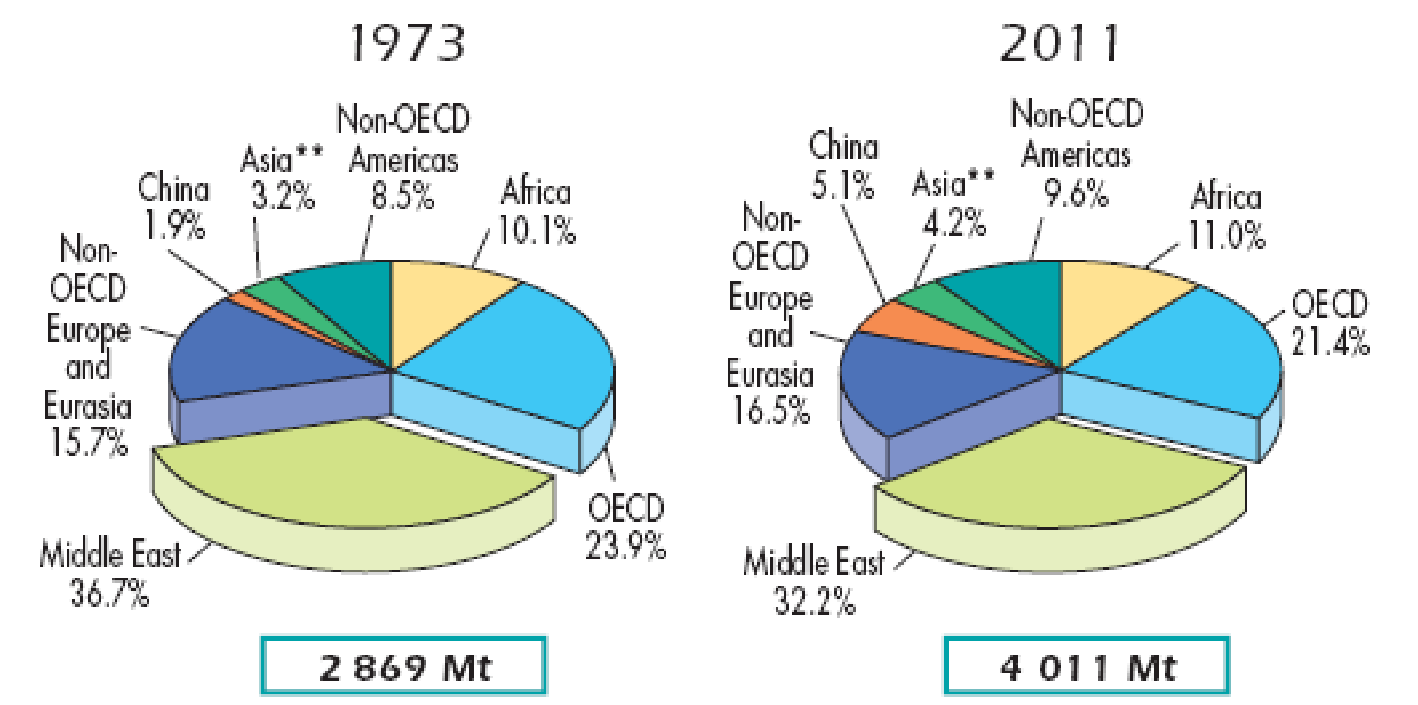
At the same time, the demand of natural gas has increased over time, for instance, natural gas meet the demand of 16% of total consumption in1973 while it boosted 5% by 2010; In addition, OECD countries supply more than 71% of total natural gas; however, the next figure gives more information in this regard:
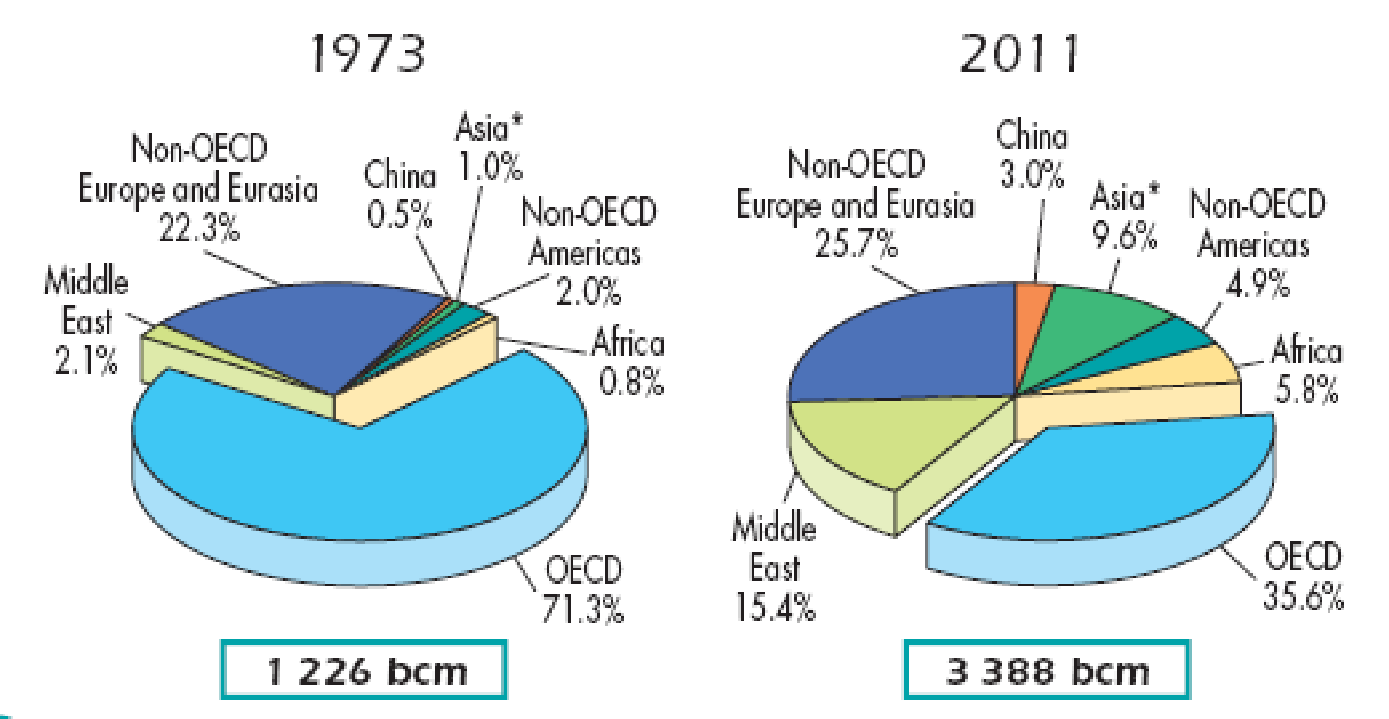
The demand of coal has enlarged from 1973, for example, coal meet 24% of total demands of energy resources in 1973 while it increased 5% by 2010; here it is important to mention that China solely supply more than 45% of the total coal of the world; however, the next figure gives more information about coal shares in global context:
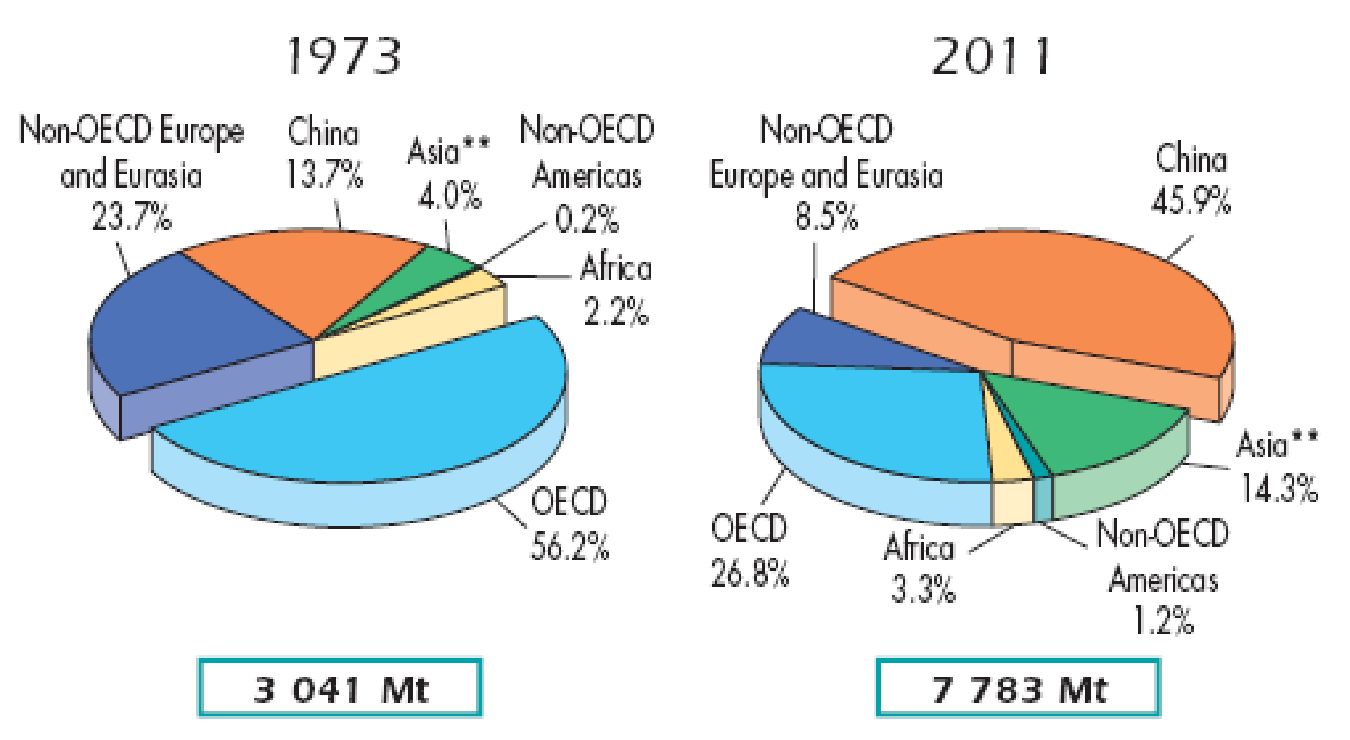
High prices for Current sources
IEA (2012, p.45) represented that oil price has increased over time, for example, oil price in the global market was more or less than US$ 20 per barrel in 1990s while it exceeded US$ 140 in 2008 though this price decreased subsequently, but it remains high; however, the next graph shows crude oil spot prices in US$/barrel:
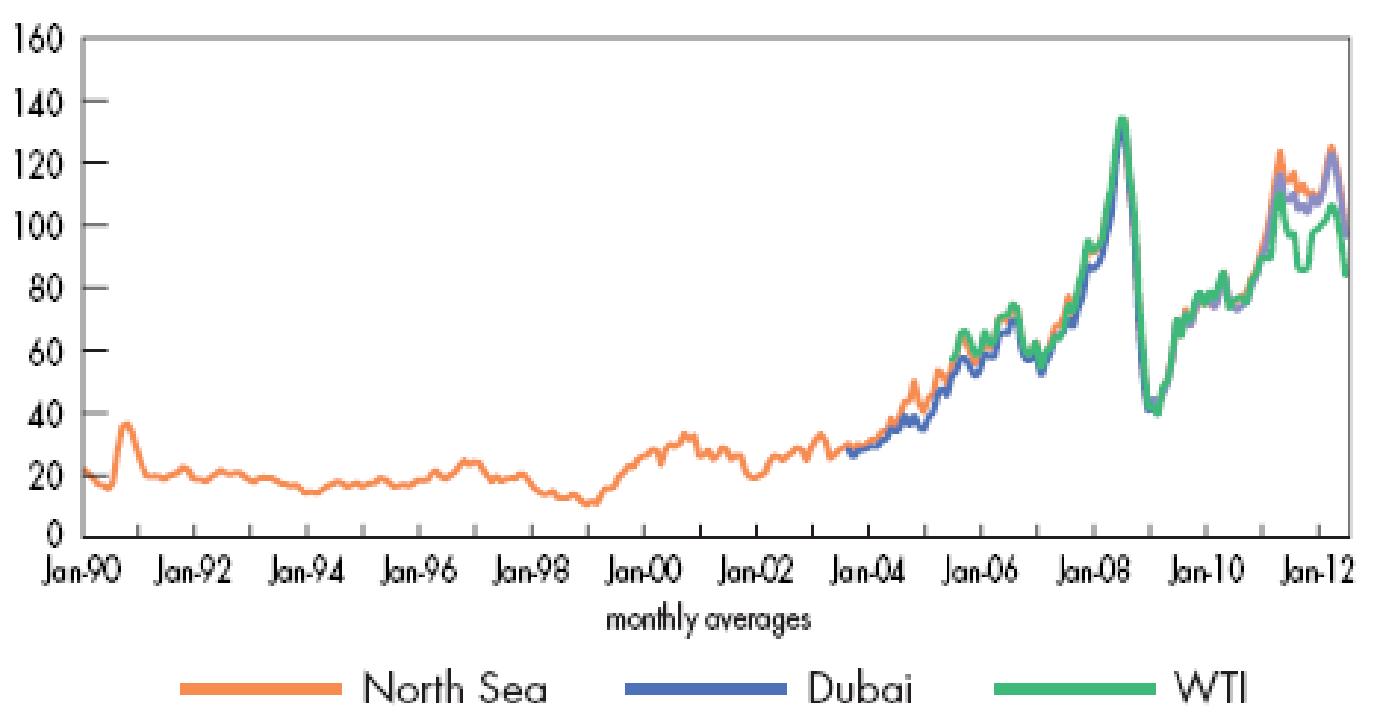
At the same time, import price of natural gas has increased eventually, for instance, natural gas price in the global market was more or less than US$ 6/MBtu from 1980s to 1990s while it exceeded US$ 15 in 2011; however, the next graph shows Natural gas import prices in US$ /MBtu:

On the other hand, import price of steam coal was in stable position for a long-time, for example, coal price in the global market was more or less than US$ 60 per tonne from 1980s to 1990s while it exceeded US$ 15 in 2011; however, the next graph shows steam coal import costs in US$ per tonne:
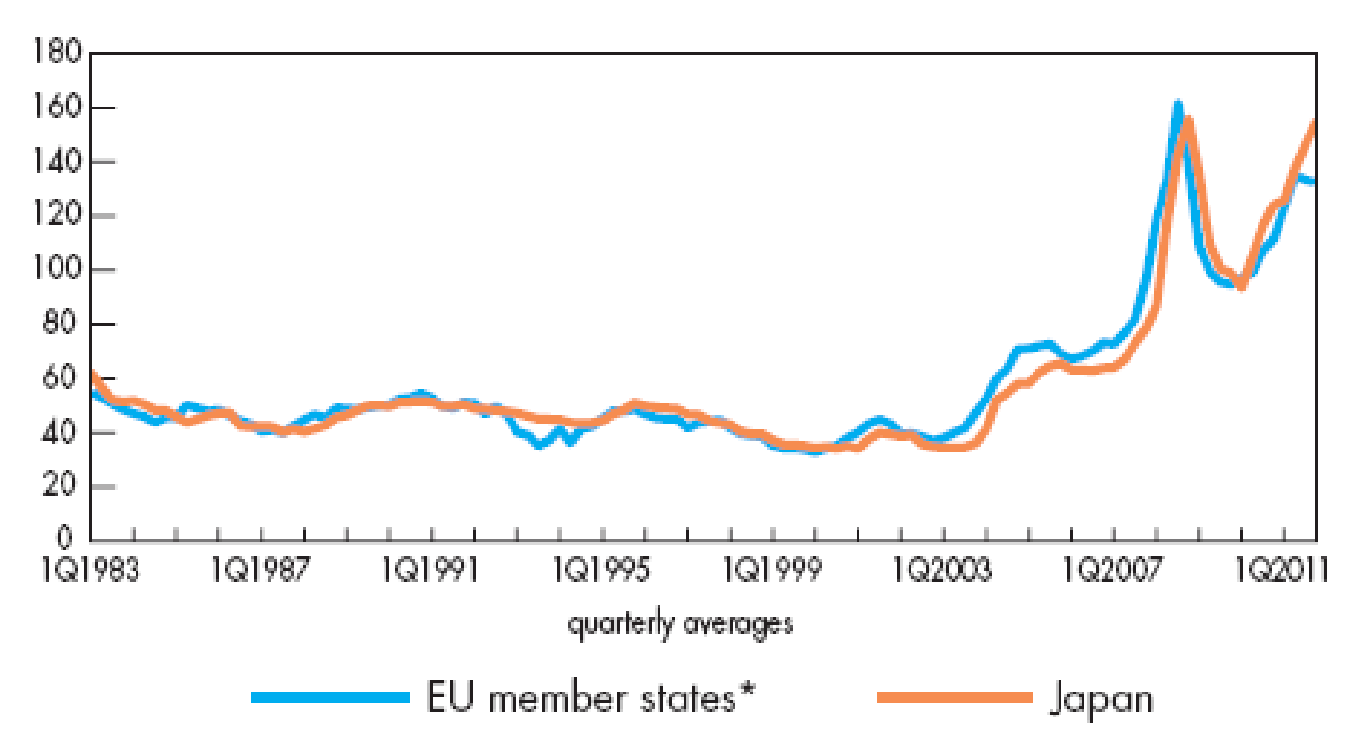
According to the report of Worldwatch Institute (2013), the world can expect energy prices to maintain usually rising spiral in the future since there is no significant initiative to change the basic policy for the management.
Different Types of Renewable Energy Sources
Geothermal Energy
Herzog et al. (2001) stated that geothermal Energy is the natural heat within the earth, which remains in the Earth’s core; however, the temperatures of 4000 miles underneath the surface of Earth is above 9000° F; now, it is feasible to find and drill into hydrothermal reservoirs, pipe the steam or hot water to use the heat directly. At the same time, it is also possible to transfer the heat into electricity (Kruger, 2006; Morgan, 2009; Peltier, 2010; Fridley, 2010; WWF, 2011; Rosentrater & Al-Kalaani, 2006 and Herzog et al., 2001). According to the report of BBC (2013) and Department of Energy (2001), direct use includes heating buildings for a number of commercial and industrial purposes, for space heating, aquaculture, and industrial processes; however, it can use from anywhere in the world, but it is unevenly distributed, seldom concentrated to be exploited industrially and economically.
At the same time, the US government has already established geothermal power plants in four regions in order to generate more than 2800 MW of geothermal electricity (BBC, 2013); in addition, North America and Latin America jointly generate about 3800 MW while EU nations and other European countries collectively produce only 866 MW. On the other hand, 53% of people of North America and Latin America had benefited from geothermal power plants, but only 10% of people of Europe had benefited from this sector; here, it should note that more than 52% of European people directly use geothermal energy. However, the following figure gives more details about geothermal electricity generation capacity:

Furthermore, Herzog, et al. (2001, p.44) stated that geothermal energy has limited prospect in the industrial countries where installed electrical capacity is already very high, but it can contribute in the developing countries with limited electricity consumption; however, the next table shows electricity production capacity by country:
Table 2: Installed geothermal electricity production capacity from 1990 to 1998. Source: Herzog, et al. (2001, p.43).
The technology of electricity production from geothermal energy is environmental friendly because carbon emission into the atmosphere /kWh is well below the figures for natural gas, oil, or coal-fired and power plants (Kruger, 2006; Morgan, 2009; Fridley, 2010; WWF, 2011; REC, 2013; and Herzog, et al. 2001, p.43). Here, it is important to mention that the multinational companies or most of the governments of the developing countries had not moved to generate electricity using geothermal energy considering the fact it should require huge investment to adopt this new technology by avoiding financial risks; in addition, it will increase cost in spite of savings (Anny et al., 2008).
Biomass and Biofuel
Biomass indicates organic matter for example timber and crops (Coppice, Reed Canary Grass and Oil Seed Rape, Elephant Grass) grown especially to be burnt to produce heat and power (Bracmort, 2013; and REC, 2013); in addition, Renewable Energy Centre mentioned that Woody biomass, animal wastes, and aquatic biomass also use to serve the same purpose. However, bioenergy is the conversion of biomass through all the types of biomass that are not used to generate energy; in addition, the researchers identified that there are many other sources of biomass, but most of them come from the land (Bracmort, 2013; REC, 2013; and Herzog, et al. 2001, p.43). Here, the next chart demonstrates biomass and bioenergy flowchart:

From the above-mentioned figure demonstrates the sources of biofuels; however, liquid biofuels generate by converting solid biomass to use in the transportation sector (Peltier, 2010; Fridley, 2010; WWF, 2011; Department of Energy 2001; and Herzog, et al. 2001, p.11). Nowadays, the most familiar biofuel is ethanol (the largest source of ethanol is corn), which make from the fermentation of biomass; however, biodiesel (made from vegetable and animal fats) becomes popular in the transportation industry (Department of Energy 2001; and Herzog, et al. 2001, p.11).
At the same time, IEA (2012, p.45) provided data related to fuel shares of total primary energy supply of the year 1973 and 2010, which demonstrated that biofuels and waste were occupied more than10% shares of the total energy supply; in addition, biofuels and waste hold 12.7% shares in case of fuel shares of total final consumption in 2010. At present, most households in developing nations are using bio-fuels due to low costs though they switch off the use of biomass when the purchasing power of the individual increases; above all, biomass and bio-fuels will contribute a significant role in the future global energy supply because the people will be aware of the climate change (Herzog, et al. 2001, p.11).
Carbon Neutral
Most importantly, the Department of Energy (2001) stated that the use of biomass instead of coal or with coal in the coal power plants and related industries could decrease carbon emission along with costs; in addition, the use of this energy helps the owner of industry and plants to decrease nitrous oxide emissions and sulphur dioxide emissions. Therefore, the multinational companies or government of the developed and developing countries had derived to generate bioenergy by using biomass and bio fuels considering the fact it should not require a large investment to implement this plant in the industrial sector; additionally, it reduces environmental hazards (Department of Energy 2001; and Herzog, et al. 2001, p.11). On the other hand, it is notable that the carbon flux is the process by which it is possible to measure carbon neutrality and bio-fuels had considered carbon neutral fuels; therefore, the following figure compares Cumulative GHG flux for biomass and fossil fuel for the last 150 years:
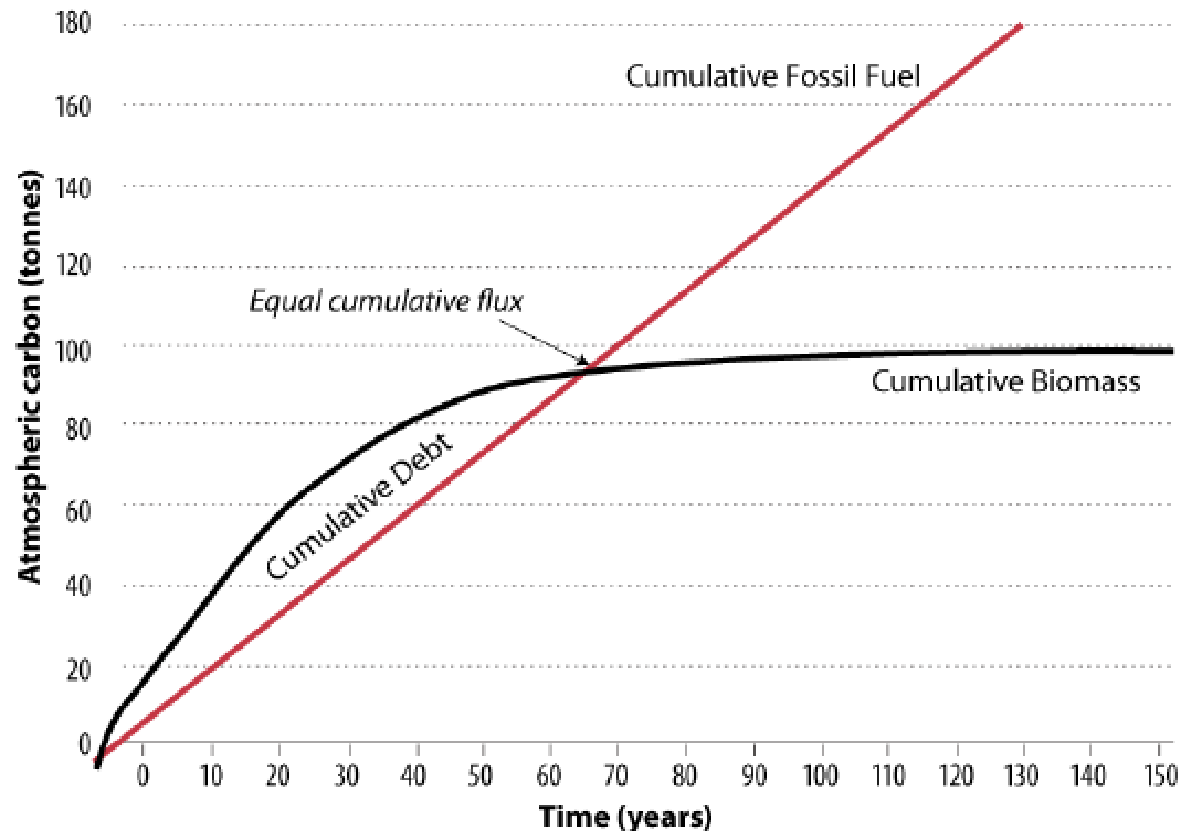
Bracmort (2013, p.16) stated that Bio-power’s carbon neutrality is a controversial issue of the bio-energy debate as the parameters include many reasons, such as
- The types of feedstock and unsustainable harvests of biomass feedstock;
- The supervision and procurement of the energy resource (particularly for the biomass, how the feedstock is handled and harvested);
- Moreover, the feedstock transportation system;
- At the same time, the energy production technology;
- Finally, the period of time to replenish the feedstock that helps determine CO2 sequestration rates
Wind Energy
Wind is the prospective clean energy source in terms of availability and environmental concerns at the time of power generation; this is considered a useful source in China, India and Persia over 2000 years ago (Bracmort, 2013; Department of Energy, 2001; Peltier, 2010; Fridley, 2010; WWF, 2011; and Herzog, et al. 2001, p.11). The demand for this source had decreased in European countries because of industrialization, but the importance of this energy had risen from the 1970s due to the global financial downturn and increase in oil prices; therefore, the government of the USA and Denmark have increased budget to use this source properly and they experienced a dramatic improvement in wind technology (Bracmort, 2013). Moreover, it is the fastest-growing source of energy; however, the researchers have identified that windmills are popular to the people, but nowadays wind turbines are a much more efficient technology to the people of developed countries (Worldwatch Institute, 2013; Bracmort, 2013; Department of Energy, 2001; Peltier, 2010; WWF, 2011; and Herzog, et al. 2001, p.11). However, the following figure gives more details in this regard:
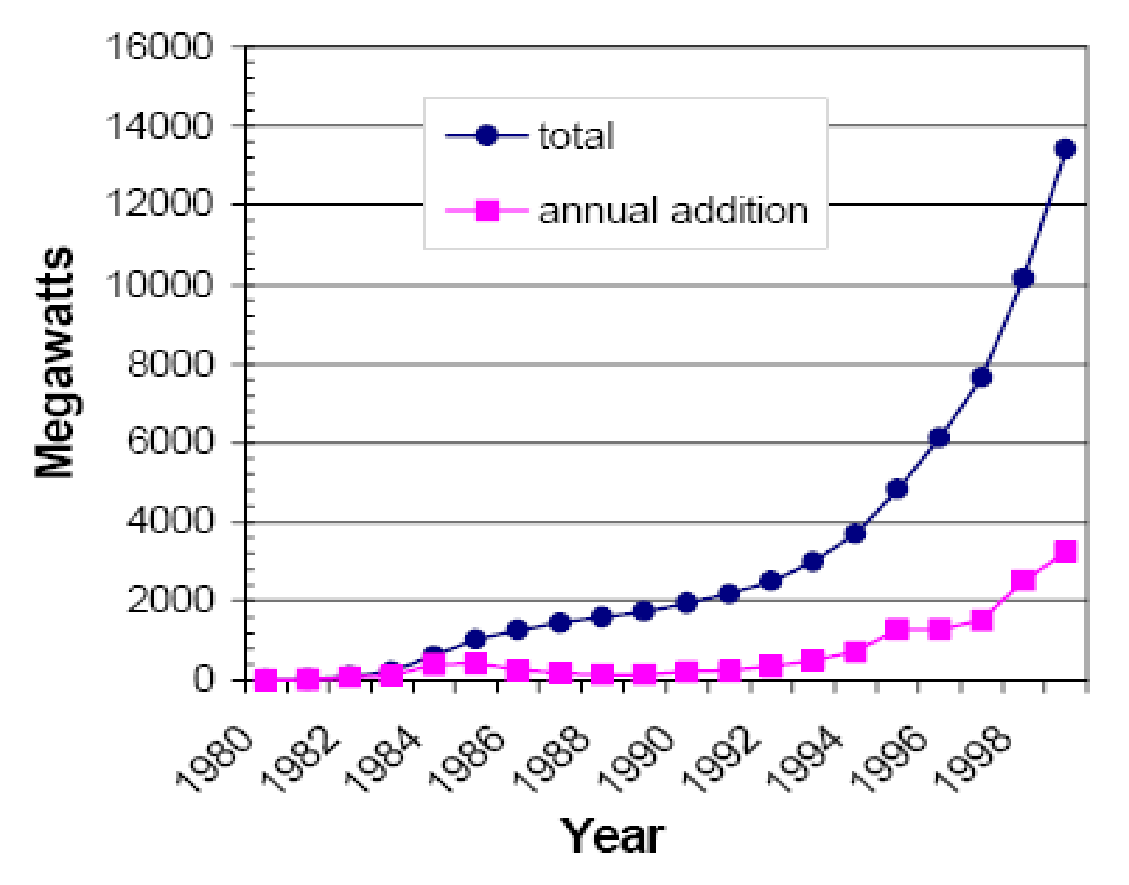
Global wind generating capacity increased by 30% in 1999 and with sales of roughly US$2 billion in 1998 for which it became one of the most expanding industries in the globe; therefore, different institutions, WWEA and the government of developed countries have tried to develop this sector for the future (Worldwatch Institute, 2013; and Herzog, et al., 2001). For instance, the thirteenth World Wind Energy Conference will be held in China in 2014 to match production and demand of energy; in this conference, national and international companies will get a chance to contribute through their innovation and joint collaborations among the parties (Worldwatch Institute, 2013; and Herzog, et al., 2001, p.26). On the other hand, it is cost-effective renewable energy technology to produce electricity from this energy since total cost decreased by more than 80% and it will decrease by 20% within 2015; however, the next figure shows the trends in wind energy costs in more details:
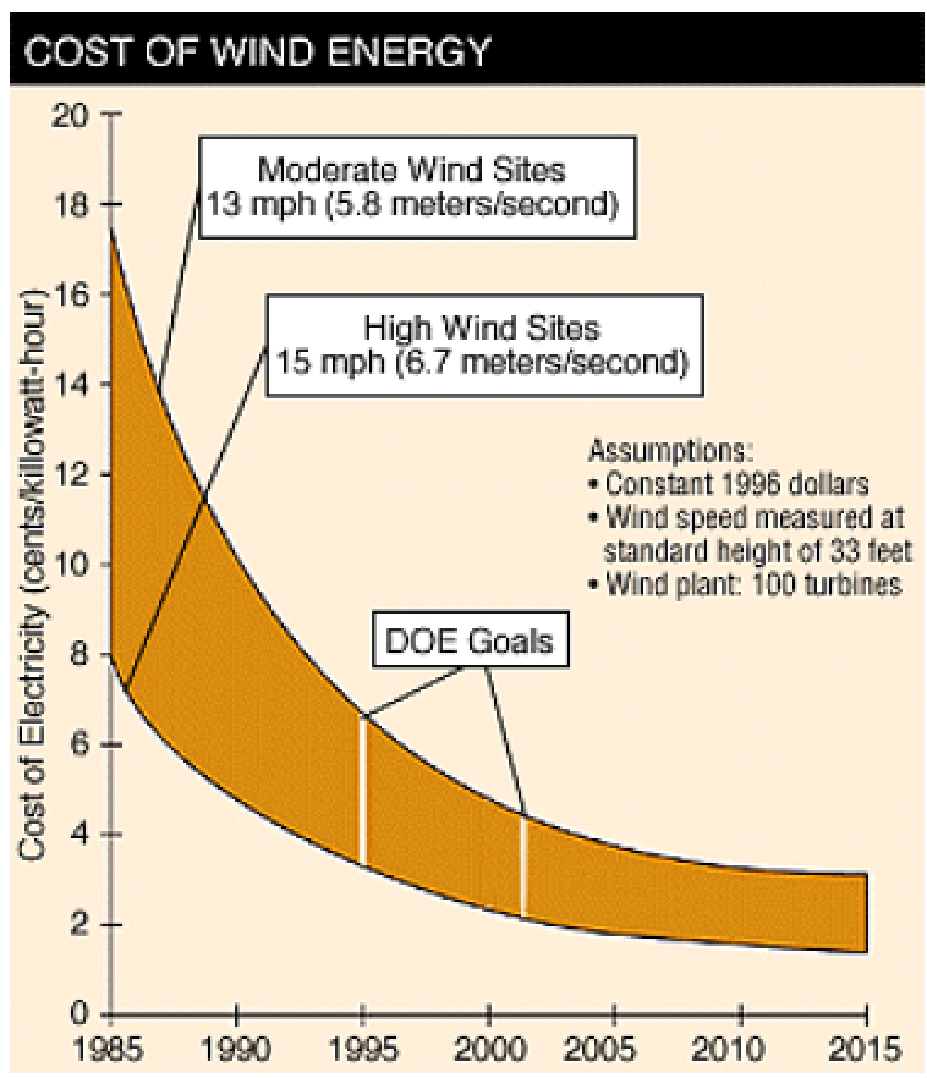
The multinational companies have jointly contributed to make it popular to the global market considering the main strengths, such as
- The machinery and set up costs are very low comparing with the resources (Herzog, et al. 2001, p.27);
- Very useful to generate electricity;
- Financially competitive regarding renewable energy sources
The people of the world faced severe problems, such as, climate change, greenhouse gas emissions, and growing oil prices; therefore, the policy makers take effective emergency measures to preserve the amount of energy available within the globe and to use alternate energy for the economic development and growth; however, the following figure more gives more information about the wind energy:

2.5.5 Solar Energy:
Solar photovoltaic and solar thermal technologies convert sunlight into useful forms of energy; however, solar energy is used to produce heat, light, and power (Department of Energy, 2001; Morgan, 2009; Peltier, 2010; Fridley, 2010; Bracmort, 2013; WWF, 2011; and Herzog, et al. 2001, p.11). At present, PV cells are most effective in bright sunlight and solar water-heating systems can be used to heat water; however, solar energy is not too popular to produce energy, but near future, it will capture a large market share; the next figure more gives data about the countries with the most installed solar energy in MW:
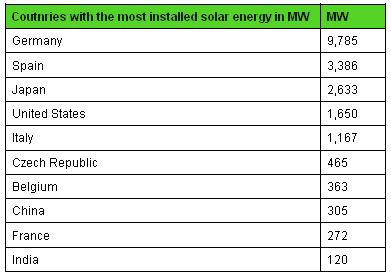
Law & Legislation
Carmak & Ergun (2012) reported that there is no unified regulation to regulate the renewable energy resources through Global Renewable Energy Guide compares the laws of 36 countries in the world to harmonize this sector; this guide represented that nine developed countries provide additional incentives, twenty-eight countries give tax benefits and twenty-five nations ensure good distribution system. The European Union had taken different measures in order to introduce a renewable energy directive and it passed the EU Electricity Directive (96/92/EC), which outlined a radical reform of electricity regulation, for instance, it focused on the reduction of public monopoly to decrease competition and to enhance the development of renewable energy through private companies and individuals. At the same time, the demand for wind energy will increase 15% in the EU market by 2020 for Directive 2001/77/CE of the European Wind Energy Association came in to force; the prime goal of this directive was to ensure smooth growth as this energy can provide half of Europe’s power by 2050 (EWEA, 2011). The governments of EU member states, North America and Asia Pacific region had already changed their policy to implement renewable energy projects and reduce tariffs under different laws, for example, EEA Agreement, renewable electricity Directive, 2001/77/CE, Federal legislation of the US perspective, and so on.
Business Scope for Alternative Energy Resources
UNEP (2012, p.4) reported that the environmental policy, regulation for the green economy has generated tremendous new commercial opportunities for the global business communities in the low carbon, green energy, and ecosystem service markets both in the developing and developed countries. It has been predicted that the biodiversity market would generate an opportunity for market growth around US$ 10 billion within 2020 while in 2008, the revenues of the alternative energy companies (globally working with solar, wind, and biomass markets) had raised around US$ 116 billion for only five years’ effort. Due to the global financial crisis in 2008 and its consequential recessionary impact directed to align with the green economy as a mitigating measure and it has anticipated that the engagement of new technology for alternative energy would gain rapid growth with a US$ 300 billion annual boost by 2020.
To support the prediction, UNDP (2012, p.6) presented the Siemens case study of Germany that illustrated rising demand and business prospect for the alternative energy resources those engaged with well-organized clean technologies at the range, which is increasingly competitive for operation, management, along with sales growth and length of renewable extent. The continuous efforts of Siemens turned it as the pioneer of offshore wind turbines and it has already installed 2,000 MW wind power stations globally, which is 50 % of the worldwide projects those are in operation and they save around 4 million tonnes of carbon dioxide (CO2) per year in relation to the conventional power generation from finite energy resources. Siemens already installed wind power in the UK at “Gunfleet Sands” with an aggregate capacity of 173 MW and ensured uninterrupted power supply at 120,000 households without any environmental hazards while the similar capacity of conventional power stations in the UK has been producing 400,000 tonnes of CO2 per year.
Research Methodology
Introduction
This chapter describes the methodological framework and research process in order to investigate the possible use of alternative energy sources by the already existing along with the possible future resources.
Primary Research
According to the statement of Vibhute & Aynalem (2011), and Saunders, Thornhill, and Lewis (2003, p.32), primary sources include unique information as well as observations, surveys, interviews, ethnographic research, actual and in-depth information, which needs to collect from the interviewees or from the published papers, such as the government reports related with policy, treaties and legal frameworks. However, this dissertation will use primary data from respondents, but use primary data from published sources related to the law on energy, such as the New Renewable Energy Directive, EEA Agreement, renewable electricity Directive, 2001/77/CE, the Act 17/2007, Directive 2001/77/CE of European Wind Energy Association, Federal legislation of the US perspective, and so on.
Secondary data
Secondary resources are very useful to analyze the current position of alternative resources, the importance of renewable energy resources, the contribution of multinational companies on business, the role of the government in this regard, use of alternative energy, and the possible future resources, in addition, these sources play a vital role to support the research topic. The researcher has the scope to collect reliable and inexpensive sources within a short period from different sources; here, online journals, web-based articles, and books are the main source of information to describe the current position of renewable energy resources, the type of predominant energy resources, technological development and consumption of energy, and energy potential of renewable energy sources and so on. This paper will take data from many books of renowned authors, for example, alternative energy sources by Morgan (2009) and alternative energy resources: the quest for sustainable energy by Kruger (2006) will be used to analyze the volatility of the price of existing resources, examines energy use throughout history, find a suitable replacement energy source, exponential expansion of energy use.
Descriptive and analytical research
Saunders et al. (2003, p.35) stated that descriptive research approach is used to explain the features of target groups or phenomenon being studied for which it has not considered the question about how/when/why the features occurred, but it focuses on the question about what. Most importantly, this dissertation will consider this approach to some extent though the research questions have not supported To use of this approach; however, it needs to consider to describe phenomena and to explain the characteristics of renewable energy and their effect on the business.
Furthermore, the analytical approach is a continuation of descriptive research, which assists the researcher to analyze and illustrate the phenomenon related with the question why or how to assess the causal relations between the issues and relevant facts (Vibhute & Aynalem, 2011); it applies this approach to estimate the position of alternative energy sources reconsidering the already existing and possible future resources.
Scope and Limitation of the study
There is huge research with the existing and alternative renewable energy resources both in the public and in the private sector; those would assist the present researcher to collecting secondary data from those scholarly works, information available from those sources have enhanced scope to organize this dissertation. The available data and engaged indicators of assessing the energy resources are not harmonized, although such data for developed counties have predestined clear explanation, for developing countries, they are confusing in nature and suspicious to use; therefore, this is a vital limitation for this study.
Critical Appraisal
Table 3: Literature Search of the Previous Research. Source: Self generated.
Data Structure and Collection
Data Collection
The author of this mini-dissertation had search literature from the articles of different researchers and identified that they had compared the position renewable resources using many parameters or statistics, but they did not gather primary data by interviewing the target groups. In addition, the research of present study had considered time limit to select research approach, which not support to use of quantitative or qualitative research; therefore, data collection based on main secondary data sources and published primary sources, such as relevant law, report of International Energy Agency and other governmental reports; however, the next table and figure will provide more information:
Table 3: the importance of secondary data. Source: Self-generated.
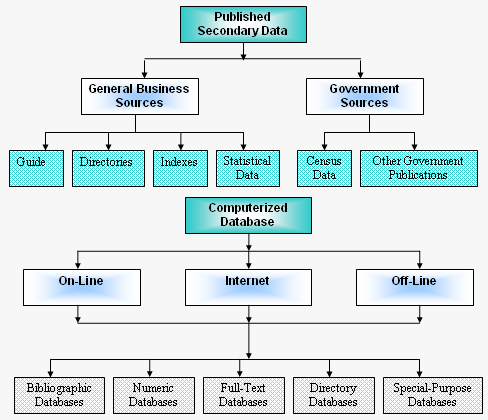
Data Analysis
There is no need to apply statistical tools for analyzing data connected with alternative energy sources along with existing and possible future resources and their impact on business because it mostly concentrated on secondary data sources and published primary data sources. In the present report, the author will compare and contrast both the primary and secondary sources on the subject of the possible use of alternative energy sources to investigate the current situation of alternative energy with non-renewable energy to identify the progress of the global energy sector. In this context, all figures and tables will be self-generated or be gathered from secondary or published data sources to analyze the possible use of alternative energy sources and their impact on business considering descriptive and analytical research approaches.
Findings and Discussion
Environmental and Social Value of Alternative Energy Business
The Union of Concerned Scientists (2013) pointed out that the increasing degree of renewable energy would essentially diminish the depressing shock to the ecosystems and human civilization caused by power generation from fossil fuels; at the same time, every source of renewable energy have exceptional reimbursement and costs by reducing carbon gas emulsion, global warming, and health risk. UNDP (2012, p.7) added that the business alternative energy resources would bring positive environmental effects while the expansion of renewable energy has an optimistic influence on the economic growth by contributing uninterrupted power supply and huge job creation, for instance, the wind power sector in Europe has aimed to generate 150,000 sustainable job opportunities by 2020. A landmark study of UCS demonstrated that the coal and fossil fuels have generated serious health risk causing breathing problems, cancer, neurological and heart diseases that accounted for US$ 886.5 billion of health impacts in the USA; in contrast, the business with Alternative Energy resources would be capable to reduce 81% of such damages, which is 6% of the US GDP. As a result, the business with renewable energy has gained well attention of the investors and a new US$263.4 billion investment would penetrate into this sector in the US market by 2025 while the other developed nations have similar investment portfolio for this business opportunity
Capital Expenditure Profit Margin and Challenges
The development of business with renewable energy would reduce capital expenditure and provide superior profit margin than the conventional energy resources due to its utilization of sustainable resources, efficient supply chains, less working capital requirement, lesser raw material cost, and lower production and operative costs. The major challenges of renewable energy are the installation cost of such project is very high while governmental policies, and changing industrial dynamics, basic economic condition, and unavailability of experienced insurance; therefore, the companies have thrown serious challenges in this sector. Thus, the most significant steps to explore the renewable energy business is to take the cost-efficient installation of the process and industrialisation in order to make available for small scale of investment and to ensure benefits for all countries; in this case, right policy landscape, project longevity, and certainty including investor’s safeguard are essential to address.
In the UK renewable energy market in 2011, AVIVA introduced its insurance coverage for LCEGS aimed to support power-generation technologies to reducing environmental hazards by providing support, consultancy, and risk mitigation factors for the companies involved to develop alternative energy resources with compliance to national regulations; however, it generated £5 million gross premium and would rise £45 million by 2015.
The Investment Opportunities of Alternative Energy Market
Douglass (2005, p.17) stated that the Investors interested to engaging some of their financial and physical resources in the alternative energy market have three levels of scopes; firstly, there are huge recognised multinationals already operating in the hydroelectric, nuclear, solar, and wind energy where the new investors could establish a joint venture with them. Secondly, there are less significant publicly listed companies engaged to developing innovative energy technologies for biomass, solar along with fuel cells where the newcomers could invest and the third scopes for new investors is to establish the privately owned non-listed companies in order to innovating experimental technologies with support and collaboration with the academia working with geothermal or nanotechnology.
For instance, large companies like General Electric has engaged itself in the alternative-energy sector with its strong investment portfolios and turned itself as a global leader for solar power; at the same time, it has been keeping major role for wind-turbine industry while it has already established as a supplier of equipment for the nuclear power station. In contrast, the multinationals working in the energy sector such as BP, RDSA, Exxon Mobil, and United Technologies have already opened new division to working with alternative energy resources although alternative energy divisions of them are still very small and contrary to their existing core businesses, but all of them look for future prospect to the renewable energy sector.
Finiteness of Existing Energy Resources and Global Economy
Krautkraemer (2003, p.1) pointed out that the literature of the economics of natural resource had started the debate whether economic growth could sustain within the finite natural energy resources in context of extremely higher growth of human population and growing resource consumption following the theory of population growth by classical economist Thomas Malthus. Although the classical economists have kept vital role to aware the individuals about the increasing scarcity of natural resources, but failed to predict any sustainable solution to the dilemma without population control, while the modern economists urged for conservation of natural resources or looked for alternative energy resources.
Perez and Perez (2009, p.1) added that the depletion of fossil fuels, enlargement of bulky new economies, environmental hazards from global warming, increasing risks of terrorism, global conflicts with markets, geopolitical unrest and economic meltdown have driven the global energy outlook to an uncomfortable level with an acute volatility to the future energy needs with economic disruptions and long-term worries. With such reality, the energy agencies and experts urged to adopt cost-cutting measures, innovating advanced new energy technologies, adopting strategies for energy saving, and to look for alternative energy resources that would ultimately mitigate the concurrent energy crisis and meet up the future requirement to overcome the environmental threats to planet. Although the traditional views, the researcher in this field considered the clean coal and nuclear energy as the alternatives energy, but these sources devastate natural resources; therefore, biomass, hydro-power, geothermal, solar, tides, wave, and wind are the actual alternative source of renewable energy those would be capable to carry out desired stable supply of the future energy requirements.
The Future of the Existing Energy Resources
Craft (2013, p.1) mentioned that the existing peak oil stage and deteriorating energy supplies correspond to the most severe crisis that the human race ever experienced the concurrent global population and the relatively luxurious lifestyle that the US citizens are enjoying is very depriving, with 5% of the global population they consume 24% of the global energy. The US with its one and half century of civilisation has strongly based on the utilization of abundant, but the finite fossil fuel resources at very cheap cost that has produced socioeconomic progress along with technological wonders, but generated serious harms to the public health and environmental hazards that all the world has to share.
After a long time and continuous effort to increase production of finite natural energy resources, the production has reached its peak level; now, the resources are naturally going down in every place all over the world, which is an attribute of the fundamental belongings to the nature and illustrated by the laws of thermodynamics (Craft 2013, p.1). From the familiar coal, oil and gas resources, the world has already consumed half of the underground energy resources those are easy to produce and better quality with less refining, and the remaining portion is difficult to produce and required superior refining, thus the production is reducing gradually. The existing energy resources is going through its peak level, increasing population, escalating food consumption, and rising energy needs carrying out unpredictable threats to the human race if there is no alternative energy resources are innovated and substantially replace the existing resources.
Recommendation and Conclusion
Recommendations
- The government and multinational corporations should reduce dependency on nuclear energy while it needs large investment to manage waste and protect environment; therefore, they should focus more on the alternative resources such as solar thermal, geothermal, wind, and tidal to produce electricity to save environment from pollution;
- It should require introducing a unified legal structure in order to use renewable energy resources by addressing all sectors of the energy system;
- It is essential to enforce a set of policy and market rules to make sure the sustainability of biomass use; moreover, the policy makers should give the highest priority on the safety of environment;
- The government of different nations have to concentrate on the factors related with financial risks and other environment barriers for which it is important to increase budget for the research and development sectors to find out the new ways and technological development to use the renewable energy resources;
- Furthermore, the governments of developing countries and policy makers should concentrate more on the bio-fuels and waste in order to meet the energy requirement as it is environment friendly and cost effective to the people of developing nations;
- At the same time, the governments of both developing and developed countries should assess the demand to increase of energy volume to prompt industrial revolution for rural development;
- This dissertation recommended to the governments of developing nations to focus more on the wind energy to experience economic growth;
- From the above discussion, it can be said that existing finite energy resources may not be able to meet the demand of different industries for which it is significant to use alternative resources in a cost effective manner to strengthen economic position; in this context, it should require join efforts of the developed countries to implement effective projects. To do so, they should focus on economic reality of the renewable energy resources, economies of scale, economic reality of the renewable energy resources, innovative and necessity of renewable resources,
Conclusion
The danger of conventional energy dependence has already recognized to the academia, multinational companies, policy makers and politicians who are promising for energy independence from the finite resources by engaging renewable energy, but that promise has not yet executed. There are no quick fixing initiatives or any remarkable progress to explore the alternative energy resources; so, the use of renewable energy at this time is very insignificant in relation to the concurrent energy consumption all over the world. To secure the globe from the possible danger of energy crisis and environmental hazards, it is emergence to come out from the ingenuity promise to improve the utilization of renewable energy; moreover, it is essential to take drastic action programme to promoter alternative energy resources by reducing installation cost that would be affordable for all nations. The governments are required to establish its energy policy pointing to the strategic target while they would be capable to meet all energy needs from the renewable resources; it is also required to provide incentives to the private sector for renewable energy generation and its technology development to bring historic progress and securing stronger, healthier, and more wealthy future.
Reference List
Anny, S. Blackman, B. & Baumol, W. J. (2008) Natural Resources. Web.
BBC. (2013). Geothermal Energy. Web.
Bracmort, K. (2013). Is Biopower Carbon Neutral? Web.
Carmak, M. & Ergun, E. (2012). Global Renewable Energy Guide. Web.
Craft, C. D. (2013). Peak Oil and Our Future: How Energy Depletion Will Change Our Lives. Web.
CSAG (2011) The Secret Lives of Energy- the Energy Problem. Web.
Department of Energy. (2001). Renewable Energy: An Overview. Web.
Douglass, S. E. (2005). Identifying the Opportunities in Alternative Energy. Web.
EWEA. (2011). Pure Power: Wind energy targets for 2020 and 2030. Web.
Fridley, D. (2010). Nine Challenges of Alternative Energy. Web.
Herzog, A. V. Lipman, T. E. Kammen, D. M. (2001) Renewable Energy Sources. Web.
IEA. (2012). Key World Energy Statistics. Web.
Krautkraemer, J. A. (2003). Economics of Natural Resource Scarcity: The State of the Debate. Web.
Kruger, P. (2006). Alternative Energy Resources: The Quest for Sustainable Energy. London, the UK: Wiley.
Lior, N. (2008). Energy resources and use: The present situation and possible paths to the future. Web.
Morgan, S. (2009). Alternative Energy Sources. London, UK: Heinemann Library.
Nagraj, A. (2013). Top 10 Countries with the World’s Biggest Oil Reserves. Web.
Oren, S. Callaway, D., Mathieu, J. & Papavasiliou, A. (2010). Renewable Energy Integration and the Impact of Carbon Regulation on the Electric Grid. Web.
Peltier, H. G. (2010) The Employment Impacts of Economy-Wide Investments In Renewable Energy And Energy Efficiency. Web.
Perez, R. & Perez, M. (2009). Fundamental Look at Energy Reserves for the Planet. Web.
REC. (2013). Biomass and Biofuel. Web.
Rosentrater, K. A. & Al-Kalaani, Y. (2006). Renewable Energy Alternatives – A Growing Opportunity for Engineering & Technology Education. Web.
Saunders, M, Thornhill, A & Lewis, P (2006). Research Methods for Business Students. London, the UK: FT Prentice Hall.
SIRET. (2013). Statistics: The top 20 countries (capacity in MW). Web.
Stern, S. N. (2007). Stern Review: The Economics of Climate Change. Web.
The US Energy Information Administration. (2013). Solar Energy Statistics. Web.
UNEP. (2012). The Business Case for the Green Economy: Sustainable Return on Investment. Web.
Union of Concerned Scientists. (2013). Benefits of Renewable Energy Use. Web.
Vibhute, K. & Aynalem, F. (2011). Legal Research Methods. Web.
Worldwatch Institute. (2013). Energy Agency Predicts High Prices in Future. Web.
WWF (2011). The Energy Report 100 % Renewable Energy By 2050. Web.